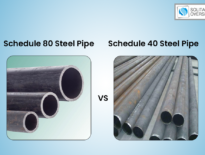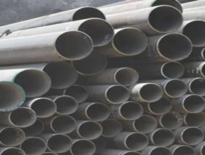Density of Stainless Steel 304
Stainless steel 304 and 304L are known by their alloy designations 1.4301 and 1.4307, respectively. Stainless steel 304 is widely used and versatile, often referred to as 18/8 due to its composition of 18% chromium and 8% nickel. This grade is easy to form, making it popular for items like kitchen sinks and cookware. Stainless steel 304L has a lower carbon content than 304, improving its weldability, especially for thicker parts. Some products are “dual certified” to meet both 304 and 304L standards. Stainless steel 304H, with higher carbon, is used for high-temperature applications. These properties apply mainly to products like sheets and pipes under ASTM A240/A240M standards, ensuring quality and consistency in manufacturing.
Density (ρ) of stainless steel 304 is 7,930 kg/m³ or 7.93 g/cm³, which equals 0.286 lb/in³. To calculate density, divide the mass (m) of the object by its volume (V), expressed as ρ = m/V. Density is typically measured in grams per cubic centimeter (g/cm³), grams per cubic decimeter (kg/dm³), or kilograms per cubic meter (kg/m³) in the International System of Units (SI).
| Stainless Steel | Density (g/cm3) | Density (kg/dm3) | Density (kg/m3) | Density (lb/in3) | Density (lb/ft3) |
| 304 | 7.93 | 7.93 | 7,930 | 0.286 | 495.05 |
Stainless Steel 304 Chemical Compositions
| Element | % Present |
| Carbon (C) | 0.07 |
| Chromium (Cr) | 17.50 – 19.50 |
| Manganese (Mn) | 2.00 |
| Silicon (Si) | 1.00 |
| Phosphorous (P) | 0.045 |
| Sulphur (S) | 0.015b) |
| Nickel (Ni) | 8.00 – 10.50 |
| Nitrogen (N) | 0.10 |
| Iron (Fe) | Balance |
Stainless Steel 304 Mechanical properties
| Property | Value |
| Comprehensive Strength | 210 MPa |
| Proof Stress | 210 Min MPa |
| Tensile Strength | 520 – 720 MPa |
| Elongation | 45 Min% |
Stainless Steel 304 Physical Properties
| Property | Value |
| Density | 8,000 Kg/m3 |
| Melting Point | 1450 °C |
| Thermal Expansion | 17.2 x 10-6 /K |
| Modulus of Elasticity | 193 GPa |
| Thermal Conductivity | 16.2W/m.K |
| Electrical Resistivity | 0.072 x 10-6 Ω .m |
Stainless Steel 304 Corrosion Resistance
Stainless steel 304 is known for its excellent corrosion resistance in various environments and against different corrosive substances. It performs well in most conditions but can be susceptible to pitting and crevice corrosion in chloride-rich environments. At temperatures above 60°C, stress corrosion cracking may occur.
Stainless Steel 304 Heat Resistance
stainless steel 304 shows good oxidation resistance in intermittent use up to 870°C and in continuous service up to 925°C. However, it’s not recommended for continuous operation between 425°C and 860°C due to potential carbide precipitation issues. For applications needing high strength between 500°C and 800°C, grade 304H is preferred, as it maintains good corrosion resistance in hot water environments.
304 Stainless Steel Heat Treatment
In terms of heat treatment, stainless steel 304 cannot be hardened by heat treatment. Instead, solution treatment or annealing is used by heating the material to a temperature range of 1010-1120°C and then rapidly cooling it to enhance its properties.
304 Stainless Steel Applications
Stainless steel 304 finds application in a wide range of industries and products due to its versatility and corrosion resistance. Here are some common uses:
- Saucepans: Stainless steel 304 is popular for its deep-drawability, making it suitable for manufacturing saucepans and cookware.
- Springs, Screws, Nuts & Bolts: Its strength, durability, and resistance to corrosion make it ideal for fasteners and small components in various applications.
- Sinks & Splash Backs: Stainless steel sinks and splashbacks benefit from 304’s resistance to corrosion and easy-to-clean properties, making it suitable for both residential and commercial kitchens.
- Architectural Paneling: Used in architectural applications for its aesthetic appeal, durability, and resistance to weathering and corrosion.
- Tubing: Stainless steel 304 is commonly used in the manufacture of tubing for various industries, including automotive, construction, and medical applications, where corrosion resistance is crucial.
- Brewery, Food, Dairy, and Pharmaceutical Equipment: Due to its hygienic properties, ease of cleaning, and resistance to corrosion, 304 stainless steel is widely used in equipment for processing food, beverages, dairy products, and pharmaceuticals.
- Sanitary Ware and Troughs: Used in sanitary applications where cleanliness, durability, and resistance to corrosion are essential, such as in bathrooms, kitchens, and public facilities.
These applications highlight stainless steel 304’s versatility and reliability in demanding environments where corrosion resistance and durability are paramount.
Why do you need to know the density of stainless steel?
Knowing the density of stainless steel is crucial because it helps in calculating the weight of the metal based on its volume. This information is valuable in several scenarios. For metal manufacturers, knowing the density allows them to accurately determine how much stainless steel they need to melt before casting it into molds. By using the volume of the mold and the density of stainless steel, they can calculate the exact weight of the metal required.
Furthermore, the density of stainless steel is used in various industries to compute the weight of different products made from stainless steel. Whether it’s steel wire, steel plates, steel pipes, or section steel, understanding the density helps in estimating their weight precisely. This knowledge is essential for designing structures, determining load capacities, and ensuring materials are used efficiently in manufacturing processes.
Conclusion
In conclusion, stainless steel 304 stands out as a highly versatile material known for its exceptional corrosion resistance across different environments. Although it cannot be hardened through heat treatment, it can be refined through solution treatment or annealing to meet specific needs. Understanding the density of stainless steel is crucial because it enables precise calculations of the metal’s weight based on its volume, essential in manufacturing processes. Overall, stainless steel 304 remains a trusted choice, widely used from everyday items like sinks and saucepans to heavy-duty components requiring enhanced weldability.
FAQs-
Is 304 stainless steel good quality?
304 stainless steel is considered good quality and is widely used globally for several reasons. It offers excellent corrosion resistance against most oxidizing acids and can withstand various environments. Its durability and ability to resist corrosion make it suitable for applications requiring frequent sanitation, such as in kitchens and food processing. Therefore, 304 stainless steel is highly valued for its performance and versatility in many industries.
Is stainless steel 304 safe for food?
stainless steel 304 is safe for food processing and handling applications. It is widely used in the food industry because it meets the necessary criteria for food safety and hygiene. Stainless steel 304 offers good corrosion resistance against various acids, making it easy to sanitize and maintain cleanliness, which is essential in food processing environments. Therefore, it is a preferred choice for equipment and surfaces that come into contact with food.
Is Stainless Steel 304 expensive?
Stainless Steel 304 is generally considered affordable and cost-effective, which has contributed to its widespread use and popularity. Compared to higher grades like 316 stainless steel, 304 is typically less expensive initially. However, 316 stainless steel offers superior corrosion resistance in certain environments and applications, which may justify its higher cost over the long term despite the higher initial investment.


